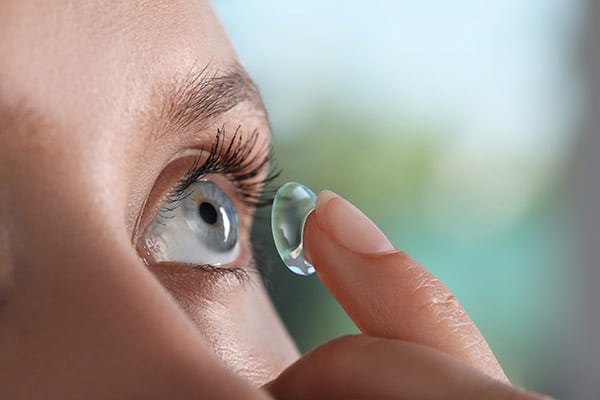Contact Lenses
Contact Lenses
There are many types of contact lenses, each with different advantages and disadvantages. Every eye is unique with different levels of dryness, refractive error and best corrected visual acuity.

There are several reasons wearing contact lenses may be beneficial including the following:
- High prescription glasses may be uncomfortable to wear because they are very thick and heavy
- The frames of glasses might obstruct some peripheral vision
- Contact lenses are a great option for sports or social events
Soft Contact Lenses
There are different contact lens options including daily disposable, bi-weekly and monthly replacement soft contact lenses. Some patients wear single vision contact lenses, while others might wear multifocal contact lenses or monovision (one eye for distance and one for near) depending on the person’s prescription.
There are also sport contact lenses available to enhance visual performance. (The Altius daily disposable contact lens offers a gray-green lens to cut out glare for sports like running, being outdoors around water and golf, as well as an amber lens for high velocity sports such as baseball and football. The contact lens is also being looked into as a possible use for patients who have a history of migraines or concussion and help mitigate symptoms with light sensitivity.)
For patients who have a very high prescription due to ocular health complications, there are custom made contact lenses available that may have a quarterly replacement schedule (depending on the brand).
Rigid Gas Permeable Contact Lenses
Rigid Gas permeable contact lenses are made of slightly flexible plastics that allow oxygen to pass through to the eyes. They usually have a smaller diameter than soft contact lenses, making it at times easier to insert than traditional soft contact lenses. High myopes may benefit from these types of lenses.
Myopia Control
Myopia is the inability to see objects clearly at far. Throughout childhood, the eye is changing and growing, and myopia can increase at a rapid rate. Slowing the progression of myopia is very important to keep the eyes healthier and to try to reduce the risk of serious eye complications including retinal detachment.
There are contact lens treatment options for myopia control for children available as well as atropine eye drops that can be used at bedtime. Potential patients need a comprehensive eye exam to determine if they are a candidate.
Prosthetic Soft Contact Lens
There is an annual replacement soft contact prosthetic lens available for patients who have a non-sighted eye that can provide cosmetic occlusion. Patients who have a history of ocular trauma and band keratopathy have used this lens for cosmesis.
The prosthetic soft contact lens is also a possible option for patients with a torn iris or traumatic dilated pupil and would like to have a smaller pupil size for cosmesis and/or reduce light sensitivity symptoms.
Contact lenses are medical devices. Wearing contact lenses carries the risk of infection, scarring and permanent vision loss. It is important to not sleep in contacts or wear them past their FDA approved wearing schedule to minimize these risks.


